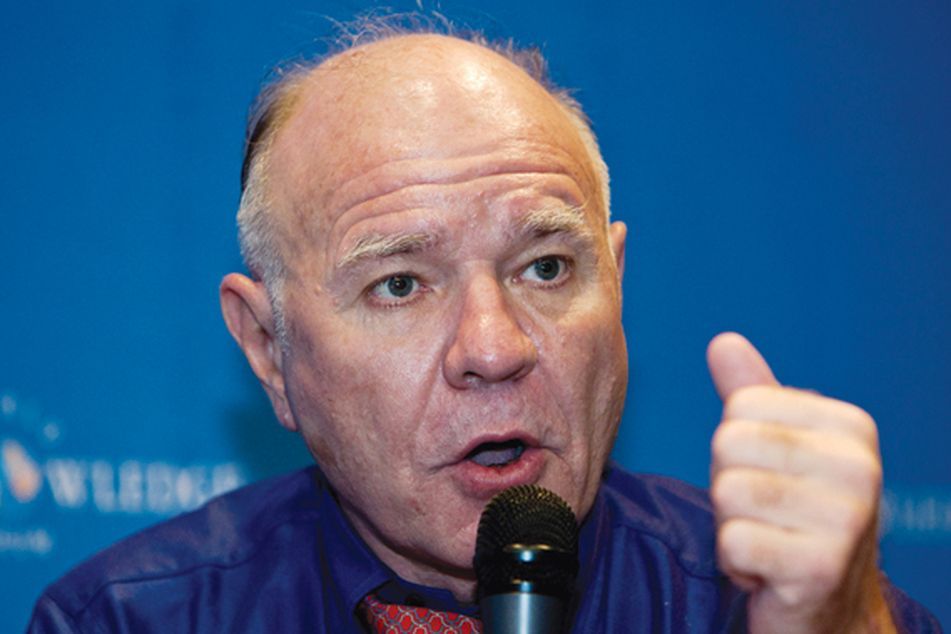Faber: Steer clear of this ‘suicidal investment’
 Faber: Change in tenor (Bloomberg News)
Faber: Change in tenor (Bloomberg News)
Investment guru says long bonds from Uncle Sam the kiss of death
A recovering economy prompted the biggest withdrawals last month from U.S. bond funds in more than two years. That was a mistake, according to Craig Brothers, a portfolio manager specializing in fixed income.
Rather than abandoning fixed-income investments for equities or cash, investors should consider shifting from the safest securities, such as Treasuries, to riskier fixed-income assets such as international debt for higher yields, said Brothers, who oversees $3 billion in assets at Los Angeles-based Bel Air Investment Advisors.
Concerns that recent outflows may signal the beginning of a bond bubble are “bogus” because individual investors’ withdrawals are a small percentage of the overall U.S. bond market, said Guy LeBas, chief fixed-income strategist at Janney Montgomery Scott LLC. Interest rates are still likely to rise in 2011, LeBas said.
“You can use other fixed-income strategies to get an equity-like return,” Brothers said. “It’s wrong to think that because rates move up you should flee.”
Nevertheless, investors shouldn’t be too aggressive when it comes to durations of bonds because demand for Treasuries is unsustainable, said Brothers. Large deficits coupled with weak employment will lead to waning demand for U.S. bonds, he said. That means investors should stay with short to intermediate portfolios with durations of no more than seven years.
Bonds with shorter durations are less volatile and a prudent defensive strategy when there’s concern that interest rates will rise, said David Santos, senior vice president and senior portfolio manager in the Boston office of Chicago-based Northern Trust Corp.
“The worst investment is in U.S. long-term bonds,” Marc Faber, who publishes the Gloom, Boom and Doom report, said in a telephone interview from St. Moritz, Switzerland on Dec. 29. “This is a suicidal investment.”
Exit, stage left
Bond mutual funds had the biggest client withdrawals in more than two years in the week ended Dec. 15, with withdrawals of $8.6 billion, according to the Investment Company Institute, a Washington-based trade group. Withdrawals were $4.4 billion in the week ended Dec. 21, the third straight week of outflows. The Standard & Poor’s 500 Index gained almost 11 percent in the fourth quarter, including reinvested dividends.
“We’re definitively at the end of the bond bull market, but it’s going to peter out rather than burst,” said Jason Pride, director of investment strategy at Glenmede in Philadelphia. That’s because there’s a wave of baby boomers moving to retirement from employment and still a huge demand for stable, constant income, which fixed-income securities provide, said Pride, whose firm oversees $19 billion in assets.
Taxable bond funds had net redemptions of $837 million compared with $3.5 billion for municipal funds for the week ended Dec. 21. Municipal bond selling picked up after Meredith Whitney, the banking analyst, forecasted “hundreds of billions of dollars” in municipal defaults in a Dec. 19 segment on CBS Corp.’s “60 Minutes,” according to LeBas of Janney Montgomery Scott in Philadelphia.
Mix masters
The negative headlines about the financial distress of municipalities are “overblown” and the core of a high-net-worth investor’s fixed-income portfolio remains having high-quality, investment-grade tax-free general obligation and essential service revenue bonds, said Alan Zafran, co-founder of Los Angeles-based Luminous Capital investment advisory firm, which manages $4 billion for about 250 families.
Rising rates means that investors also should consider adding higher yielding fixed-income securities such as emerging- market bonds to the mix, he said.
George L. Taylor, a fixed-income manager at Moss Adams Wealth Advisors in Seattle, who advises clients with an average net worth of $3 million to $10 million, said his firm has been adding to portfolios and increasing their fixed-income allocations to international and emerging-market debt through funds such as those managed by Pacific Investment Management Co. in Newport Beach, California.
Going abroad
Many clients are investing in sovereign debt and domestic high-yield bonds, said Brothers of Bel Air Advisors. The sovereign debt fund used by Bel Air has a focus on emerging- market bonds with durations of about 3 years and provides yields of about 5 percent. Brothers said he prefers U.S. high-yield bonds with durations of up to 4 years that offer yields of 7 percent. High-yield bonds are generally high-risk debt rated below BBB- by Standard & Poor’s and Baa3 by Moody’s Investors Service.
Investors should avoid dollar-denominated government debt weighed down by budget deficits and invest in bonds in Canada, Mexico and Brazil, according to Pimco’s Bill Gross, manager of the world’s biggest bond fund.
“It’s a critical strategy going forward to get out of the dollar and into some currency that holds its value,” Gross said in an interview with Tom Keene on a Bloomberg Television “Surveillance Midday” program broadcast Dec. 31.
U.S. investors added about $30 billion to world bond funds in 2010 through November compared with $16 billion a year earlier and almost $16 billion to emerging-market bond funds compared with $2.5 billion a year earlier, based on data from Morningstar.
Muni market madness
Shorter term corporate bonds are better buys than Treasuries because they provide protection from rising interest rates, said Pride of Glenmede. The firm has a greater allocation to the highest-rated non-investment grade corporate bonds, which are yielding more than 6 percent, Pride said. He said he generally chooses durations of up to 4 years. The yield on the 5-year Treasury note was about 2 percent on Jan. 4, according to generic Bloomberg data.
There’s a ‘modest outflow’ of client money from tax-exempt bonds into taxable corporate bonds rated A or better, said Ed Reinoso, who manages $300 million as chief executive officer of Castleton Partners in New York. For the highest earners paying a 35 percent federal income rate, a 3.9 percent tax-free bond yield is equivalent to a 6 percent taxable yield. Top-rated tax- exempt munis due in 10 years were yielding 3.24 percent as of Jan. 4, according to a Bloomberg Valuation index.
“It’s the first time in 18 months we’re seeing some opportunities and just starting to stick our toe in,” said Reinoso, referring to the municipal bond market, which suffered the worst fourth quarter in more than 16 years.
Fixed-income fixes
Investors buying benchmark 10-year notes will gain about 0.8 percent in 2011 once interest payments are reinvested, as the yield rises to 3.65 percent after averaging 3.2 percent in 2010, according to a Bloomberg News survey of the Federal Reserve’s 18 primary dealers. Bank of America Merrill Lynch’s U.S. Treasury Master index returned 8.1 percent annually since its start in 1978.
For higher yields, investors should consider leveraged loans funds, which are mostly non-investment grade and whose rates are based on the London interbank offered rate, or Libor, said Zafran of Luminous.
They should also consider mortgage-backed securities through hedge funds such as Rimrock High Income PLUS Fund, Zafran said. Hedge funds are lightly regulated pools of capital whose managers can invest in any asset, and share in annual profits. Rimrock requires minimum investments of $1 million for the fund.
“Saying we’re at the beginning of a bond bubble is an overstatement for a short duration portfolio,” said Brothers of Bel Air. “Our clients don’t feel like they’re missing something by staying in fixed income.”
–Bloomberg News–
Learn more about reprints and licensing for this article.






